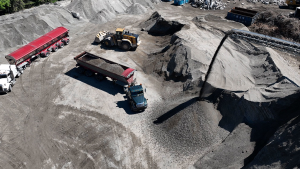Municipalities, hot mix asphalt producers and contractors now have a detailed report they can access for best practices for handling and stockpiling Reclaimed Asphalt Pavement (RAP).
Officially titled the 2022 Reclaimed Asphalt Pavements Report, it was formally presented to members of the Ontario Asphalt Pavement Council (OAPC) at its recent fall seminar.
RAP has “the potential to be a significant contributor to aggregates sustainability.” Other advantages for using it include lower roadbuilding costs and diverting large amounts of solid waste from landfill sites, it said.
A joint initiative by the Good Roads association, OAPC, the Municipal Engineers Association and the Centre for Pavement and Transportation Technology at the University of Waterloo, the report is diverse with many sections.
Besides quantifying Ontario’s RAP inventory and municipal hot mix paving quantities, it presents a number of recommendations for stockpiling the material.
For example, there should be paved surfaces under stockpiles to prevent contamination and sinking, plus the use of tarps or shelters to provide rain protection.
There are a host of other recommendations as well, such as measures to limit dust build up during processing and crushing operations.
As the report’s authors point out, some of the key objectives include documenting the history of RAP in Ontario, synthetizing best practices information, providing an information platform on successful applications and promoting its economic and environmental benefits.
The report is a compilation of several different research initiatives over a number of years by Good Roads, said its technical products and research co-ordinator Amin Mneina.
Those initiatives include a 2019 satellite survey that involved scanning 114 asphalt plant facilities using Google Earth Pro and some historic images, 2020 and 2021 surveys of the roadbuilding industry’s RAP quantities, and the findings of the association’s municipal paving forecast surveys which started in 2016, he said.
At the OAPC fall seminar where he presented the report, Mneina cited another study to underscore the importance of increased RAP use.
According to the Ontario Chamber of Commerce, aggregate sources in southern Ontario are getting depleted and moving further distances to aggregate sources could increase GHG emissions by 89,000 tonnes and $169 million in transportation costs.
Those extra costs will place an inordinate amount of pressure on Ontario municipalities that consume between 60 to 70 tonnes of aggregate annually, which collectively, makes them the biggest consumers of aggregate, he said.
“A typical municipality spends 50 per cent of its budget on construction and infrastructure,” said Mneina, noting municipalities across the nation account for 80 per cent of all public procurement and that, in turn, represents 15 per cent of Canada’s gross domestic product.
Still, there are many barriers to increased RAP use. Even though the Ontario Ministry of Transportation was one of “the first agencies worldwide” to utilize RAP, only 67 per cent of Ontario municipalities allow its use, he said.
Even in those municipalities that do permit it, there are restrictive procedures.
Most only allow it in base/binder hot mix asphalt layer and not in the surface layer, as well as imposing a maximum 15 per cent cap. Agency specifications tend to focus more on the maximum amount allowed, with scant stipulations mentioned about stockpiling and processing practices or testing, he said.
“Why are we using little to no RAP?”
Mneina said there are a number of different reasons.
Municipalities have concerns about quality and performance and limitations on quality assurance oversight, while contractors have their own concerns about municipal specifications and negative perceptions about RAP.
A single clause in the Ontario Provincial Standards Specifications is the only standard that addresses its use, he pointed out.
During the presentation Mneina also provided attendees with a recap of Good Roads’ lobbying efforts at Queen’s Park to promote increased RAP use. In late November, its board members, management and staff had 50 meetings with members of all parties.
While the MPPs were open to the association’s suggestion for incentivizing and promoting RAP use, some were less enthusiastic about a proposal that a minimum percentage of RAP in road construction and maintenance be mandated, he said.
In an interview after the seminar, Mneina said work on the report began in 2020, but then added it shouldn’t be described as “two-year report” as the sponsoring organizations had to schedule that work in with their other duties. The presentation at the fall seminar is part of an ongoing effort to promote the report, he said.











Recent Comments